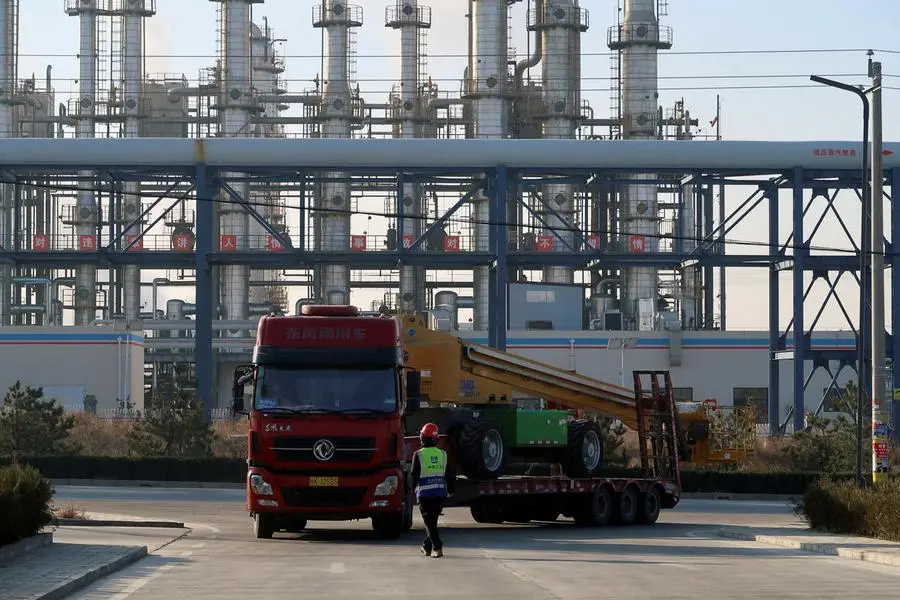PHOTO
LONDON - China has boosted domestic coal production and imports to record highs, even as surging power from hydro dams and solar farms has trimmed thermal generation during the summer heatwave.
Coal-fired generation remains critical to ensuring the reliability of electricity supplies - especially in the winter, when hydro and solar output is much lower and the system depends far more heavily on fossil energy.
Despite a record deployment of wind and solar resources, coal still provides the largest share of generation at all times of year, rising to more than 75% in the winter months.
Sufficient stocks are therefore critical to ensure thermal generators have enough fuel on hand to run flat out in the coldest part of winter.
Generators are accumulating inventories to lay in adequate fuel and avoid a repeat of power shortages that plagued the country in the autumn and winter of 2021.
COAL SUPPLIES
China's mines boosted production to a seasonal record 390 million tonnes in July 2024, up from 378 million in the same month a year earlier and 373 million in 2022.
Domestic miners have ramped up output over the summer to make up for relatively slow production in the first five months of the year.
Cumulative production in the year to July was just 15 million tonnes behind the same period a year earlier but the deficit had fallen from 54 million tonnes in the year to May.
So far in 2024, Inner Mongolia, Shaanxi and Xinjiang, three of the four top provincial-level producers, have all reported record seasonal output.
Only Shanxi, where production is broadly flat compared with a year earlier, failed to set a seasonal record in the first seven months.
Shanxi has "voluntarily" adjusted output after seven years of rapid growth to optimise capacity and increase the proportion of advanced mines, according to the government-run news agency Xinhua.
Chartbook: China electricity generation
The four top producers account for more than 80% of the country’s output and are the critical suppliers to generators in all regions, except in the far south.
At the same time, imports surged to a seasonal record of 296 million tonnes in the first seven months from 261 million tonnes in 2023 and 139 million in 2022.
Imports have been used as a substitute for the lower output from Shanxi, creating breathing space to restructure the sector.
But they are also crucial in Guangdong and other southern areas, since it is cheaper to bring coal in by sea than on long rail journeys from the far north.
DOUBLE PEAK
China's annual electricity consumption exhibits what the government terms a "double peak" in summer and winter.
The primary peak occurs between June and August, driven by airconditioning and refrigeration, which accounts for 30% of maximum nationwide load, rising to more than 40% in some provinces.
But summer is also when precipitation is highest because of the East Asian monsoon and hydro generation is maximised, easing some of the strain of the transmission network, except in drought years.
In July 2024, record output from hydro and solar parks trimmed thermal generation, mostly from coal, by 25 billion kilowatt-hours (kWh) compared with a year earlier, the first seasonal decline for at least a decade.
But the secondary peak occurs between December and February, driven by heating and lighting, not much lower than in the summer.
Winter coincides with the dry season, when hydro generation declines sharply, typically by around 50% compared with the summer.
Solar generation is also somewhat less, given shorter daylight hours across the plains of northern China, where most solar parks are located.
The result is that the electricity system is much more reliant on coal during the winter peak than in the summer one.
In the five years between 2019 and 2023, thermal generators supplied 75% of electricity between December and February compared with under 70% between June and August.
In the summer, the marginal generator is sometimes a hydroelectric station or a solar park; in winter it is always a coal-fired power plant.
The gap between summer and winter patterns is likely to widen over the next few years as the government accelerates deployment of solar parks.
Ensuring electric reliability will continue to depend on building up enough coal stocks during the spring and autumn shoulder seasons to meet peak winter demand.
John Kemp is a Reuters market analyst. The views expressed are his own. Follow his commentary on X https://twitter.com/JKempEnergy (Editing by Gareth Jones)























